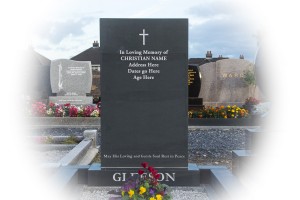
 Choosing a headstone
Choosing a headstoneMemorials to our departed have had a place and purpose since the beginning of time. From the bronze age cairns and dolmens to the ancient celtic crosses and on to the modern shapes and colours we have nowadays.
Today, cemetery headstones are a way for family and friends to memorialise their loved ones who have passed before them. They provides an everlasting shrine and a place where family and friends can pay tribute to and reflect on the life and times they had together.
Over the last twenty seven years, I have helped hundreds of families with the difficult task of choosing a headstone. Hopefully I can help you by offering some advice with regard to choosing a headstone. First, I will start with something about the natural stone we use to build the memorial.
Today, imported granite is by far the most popular stone for creating memorials. It is often referred to as “marble” but practically all the coloured polished stone you see in cemeteries today is in fact igneous rock or granite. Granite comes mainly from China and India. These large countries have a huge number of quarries and can supply a diversity of colours. Granite is extremely hard and durable making it the ideal material for use in memorials. Once polished, granite will retain its shine and luster for of years. Nothing is added to the stone during polishing only time and elbow grease.
Some coloured granites such as Paradiso, Bahama Blue and Tropical Green have a wild pattern. With these granites, colour and pattern can vary quite a lot even from one side of a slab to the other. This is a consideration when choosing a headstone with wild patterns. Talk to your memorial supplier and try to see your actual stone before completion. Other granite like Light Grey and Mid Grey are speckled and have a more uniform pattern. Being a totally natural material, even black granite will vary slightly.
Granite can be used unpolished if you like a more matt finish. Polishing seals the surface and stops contaminants from getting a foothold. If used unpolished, it can get some moss and lichen growth over the years. The upside is that unpolished granite does not wear fast and is generally not hard to clean.
In Ireland, for centuries limestone has been used for making monuments. Limestone is the blue/grey matt stone you see mainly in the older parts of the cemetery. Limestone does weather with time and will lose its blue/grey colour. This is an important consideration in your choice of material. It will need continual maintenance to keep it looking good. It lends itself well to carving and lettering as it is relatively soft and fine grained. Hand carved limestone memorials are still available today. They would usually be celtic crosses and scrolls but any shape can be made in limestone. White Italian Carrara marble was also widely used but it also weathers quickly and is not used much outdoors today. Granite is also quarried in Ireland mainly in south County Dublin and County Wicklow. Irish granite use in cemetery monuments is quite limited today mainly due to high production costs.
There are many shapes available. Probably the best place to get an idea of what is available is by visiting your local cemetery. Maybe your local memorial workshop has a showroom where you can see some examples. Try to narrow down the shapes and colours you like before choosing. Take time with your choice and be sure it is what you want. One off’s or bespoke designs can be arranged. These usually take a little longer to complete than something off the brochure.
If you rather a more rustic look, you can choose a boulder type headstone. It can have a polished, matt or an undulating face. These can be used with either polished or rough pitched granite kerbs. You can choose a headstone with a base or go for one without for a totally natural look.
Colours used on headstone lettering are usually, gold, silver, black or white. These four colours will compliment most of the stone colours available. Painted lettering and ornamentation will remain looking good for a long time as long as care is taken with the application. Gold leaf was used extensively for gilding headstone lettering. Gilded lettering eventually fails due to the limitations of the paint or “size” used to fix it to the stone. Modern acrylic metallic paints can rival the durability and longevity of gold letters on stone. They also offer a considerable time and cost saving.
Ask your memorial workshop for a mock-up drawing of the headstone with inscription. This can be emailed or posted. That way, you can check layout, dates and spelling before approving the final inscribing of the headstone.
Another consideration when choosing a headstone are local cemetery regulations. Some, like Rahoon Cemetery here in Galway have a height limit of 1.3 meters in the newer sections. Again, your memorial workshop will advise you. They will also submit drawings and specs if required for you.
Most city cemeteries have a permit fee to erect a headstone. These fees vary from one cemetery to another. As an example, Galway City Council fees for newer sections of Rahoon Cemetery for 2020. Single plots (9′ X 4′) are €144 and double plots (9′ X 8′) are €252. They are €60 in the older sections. Normally a drawing has to be submitted with your application. Your monumental sculptor does this as part of the service.
Hopefully this information has been helpful. If you need any more help, you can email me from the contact page on my site or contact me on the details below. Corrib Memorials Contact Page